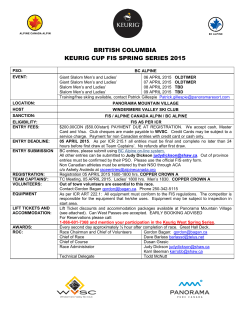
Andrei Costache, Kristian Glejbøl, Ion M
Experimental Investigation of a Basalt Fiber Reinforced Composite to Metal Joint 1,2 2 1 1 A. C OSTACHE , K. G LEJBØL , I. M. S IVEBÆK , C. B ERGGREEN 1 2 DTU M ECHANICAL E NGINEERING , N ATIONAL O ILWELL VARCO R ESULTS C ONTRIBUTION This study investigates the possibility of anchoring a basalt fiber reinforced polymer (BFRP) in an aluminum grip [1] using dry friction. The pull-out force vs. clamping pressure will be investigated, together with the surface finish effect and wear pattern. High density polypropylene (HPP) and high density polyethylene (HDPE) has been tested. This tests serve as a benchmark for the BFRP results. It is clear that the HPP is fairly close to the results in configuration a. This indicates that the friction is matrix dominated, even if there is some degree of fiber contact. 4 F [kN] 3 2 P1 P2 P3 1 0 0 0.05 M ODEL 0.1 0.15 mm 4 Config b Config a 2 0 0 Left Grip BFRP LG3 LG2 P3 P2 5 P1 20 4 Right Grip RG3 10 20 clamping F [kN] 30 3 Higher pull-out force is obtained if the grips are sandblasted. In this way the roughness is increased, as well as contact area. The grip asperities also get into contact with more of the fibers, which have a higher coefficient of friction then the matrix. 50 40 30 CoF BFRP =0.25 CoF BFRP =0.31 CoF PP =0.22 CoF HDPE =0.11 20 10 0 0 HPP HDPE 50 100 Normal Force [N] 150 2 1 RG2 0 0 LG1 10 15 clamping F [kN] The two configurations have been tested at several clamping forces. Several repetitions have been done to achieve a statistical valid result. It is clear that there is a lot of scatter between the results.This is more obvious for the configuration where the specimen extends on both sides of the clamp. This behavior is due to the clamps digging into the BFRP. pull-out F [kN] The displacement of three reference points that are tracked with DIC. A reference plane is used to remove unwanted rigid body movement. 5 3 1 D ISPLACEMENT CALIBRATION 10 0 0 Friction Force [N] Grips Grips The displacement is recorded with digital image correlation. It is important to monitor the actual displacement of the specimen in the grips, in order to get the exact pull-out force when the BFRP slips. SB max SB 5 Strain Gage Strain Gage 15 pull-out F [kN] During a pull-out test the three tracking points displace at different rates. This effect is more apparent as the clamping force is increased. The maximum force at which the clamp fails is considered at the onset of displacement for the third point. pull-out F [kN] A special test rig has been constructed, which can hold the grips and the specimen. This setup will be on one side attached to a load cell, and displacement is applied to the BFRP. A special system has been constructed, which can precisely record the clamping force via strain gages. It is thus possible to ensure uniform clamping pressure. RG1 5 10 15 clamping F [kN] 20 The coefficient of friction is measured for all materials. The polypropylene and BFRP coefficient of friction are close, which helps explain the similar behavior in pull-out tests. Reference y z x The highest load that can be safely produced by the grip is the load at which point 3 starts to move. W EAR flat grips F UTURE W ORK sandblasted grips • Force control tests to estimate ultimate pull-out force in cyclic loading. • Improved geometry T EST S ETUP configuration a • Test for creep effects. configuration b Test configurations showing the BFRP specimen and clamp configuration. In configuration a the specimen does not extend outside of the grips. For configuration b, the specimen extends on both sides of the grip. Mechanical interlocking appears where the grips make local indentations in the specimen. R EFERENCES The flat grips wear marks are localized towards the edges of the specimen. This indicates a small contact area. Fiber breakage is concentrated where the matrix delaminates. The sandblasted grips have produced more uniformly distributed wear, with smaller damage areas. Fibers are mostly intact. [1] J. W. Schmidt, A. Bennitz, et.al. Mechanical anchorage of FRP tendons - A literature review. Construction and Building Materials, Vol. 32, pp 110-121, 2012. C ONTACT I NFORMATION Andrei Costache / DTU Mechanical Engineering +45 45251391 / ancos@mek.dtu.dk A CKNOWLEDGMENT The guidance and support from Kristian Glejbøl, from National Oilwell Varco, Subsea Production Systems, as well as the economic support from the Danish Agency for Science, Technology and Innovation are gratefully acknowledged.
© Copyright 2025












